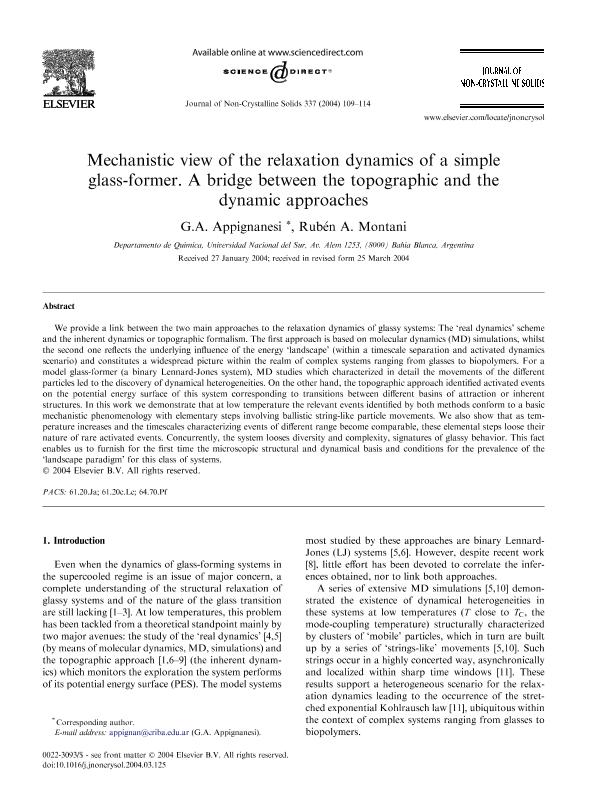Mostrar el registro sencillo del ítem
dc.contributor.author
Appignanesi, Gustavo Adrian

dc.contributor.author
Montani, Ruben Alfredo

dc.date.available
2020-02-07T18:44:11Z
dc.date.issued
2004-07
dc.identifier.citation
Appignanesi, Gustavo Adrian; Montani, Ruben Alfredo; Mechanistic view of the relaxation dynamics of a simple glass-former. A bridge between the topographic and the dynamic approaches; Elsevier Science; Journal of Non-crystalline Solids; 337; 2; 7-2004; 109-114
dc.identifier.issn
0022-3093
dc.identifier.uri
http://hdl.handle.net/11336/96899
dc.description.abstract
We provide a link between the two main approaches to the relaxation dynamics of glassy systems: The 'real dynamics' scheme and the inherent dynamics or topographic formalism. The first approach is based on molecular dynamics (MD) simulations, whilst the second one reflects the underlying influence of the energy 'landscape' (within a timescale separation and activated dynamics scenario) and constitutes a widespread picture within the realm of complex systems ranging from glasses to biopolymers. For a model glass-former (a binary Lennard-Jones system), MD studies which characterized in detail the movements of the different particles led to the discovery of dynamical heterogeneities. On the other hand, the topographic approach identified activated events on the potential energy surface of this system corresponding to transitions between different basins of attraction or inherent structures. In this work we demonstrate that at low temperature the relevant events identified by both methods conform to a basic mechanistic phenomenology with elementary steps involving ballistic string-like particle movements. We also show that as temperature increases and the timescales characterizing events of different range become comparable, these elemental steps loose their nature of rare activated events. Concurrently, the system looses diversity and complexity, signatures of glassy behavior. This fact enables us to furnish for the first time the microscopic structural and dynamical basis and conditions for the prevalence of the 'landscape paradigm' for this class of systems.
dc.format
application/pdf
dc.language.iso
eng
dc.publisher
Elsevier Science

dc.rights
info:eu-repo/semantics/openAccess
dc.rights.uri
https://creativecommons.org/licenses/by-nc-sa/2.5/ar/
dc.subject.classification
Físico-Química, Ciencia de los Polímeros, Electroquímica

dc.subject.classification
Ciencias Químicas

dc.subject.classification
CIENCIAS NATURALES Y EXACTAS

dc.title
Mechanistic view of the relaxation dynamics of a simple glass-former. A bridge between the topographic and the dynamic approaches
dc.type
info:eu-repo/semantics/article
dc.type
info:ar-repo/semantics/artículo
dc.type
info:eu-repo/semantics/publishedVersion
dc.date.updated
2019-11-27T14:54:08Z
dc.journal.volume
337
dc.journal.number
2
dc.journal.pagination
109-114
dc.journal.pais
Países Bajos

dc.journal.ciudad
Amsterdam
dc.description.fil
Fil: Appignanesi, Gustavo Adrian. Consejo Nacional de Investigaciones Científicas y Técnicas. Centro Científico Tecnológico Conicet - Bahía Blanca. Instituto de Química del Sur. Universidad Nacional del Sur. Departamento de Química. Instituto de Química del Sur; Argentina
dc.description.fil
Fil: Montani, Ruben Alfredo. Consejo Nacional de Investigaciones Científicas y Técnicas. Centro Científico Tecnológico Conicet - Bahía Blanca. Instituto de Química del Sur. Universidad Nacional del Sur. Departamento de Química. Instituto de Química del Sur; Argentina
dc.journal.title
Journal of Non-crystalline Solids

dc.relation.alternativeid
info:eu-repo/semantics/altIdentifier/doi/http://dx.doi.org/10.1016/j.jnoncrysol.2004.03.125
dc.relation.alternativeid
info:eu-repo/semantics/altIdentifier/url/sciencedirect.com/science/article/pii/S0022309304003047
Archivos asociados
